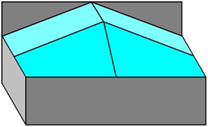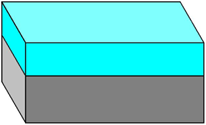Introduction
Where both sides of a bin are roughly the same height, the LVS uses a modified ‘level load’ method to estimate the volumetric capacity of the bin.
For some special applications such as snow recovery the load material may be blown into the truck from one side by a specialised machine. In this case the truck bins are sometimes modified with an extension to the wall along the opposite side from the blower to create a bin with one low side and one high side.
Where one side of a bin is significantly higher than the other (more than 300mm higher on average) the LVS adds a correction volume to the computed level load estimate (based on the lower side) to account for the increased capacity.
By default, this high side correction volume is equivalent to half the difference between a level load taken from the lower side and a level load taken from the higher side.
The LVS supports a custom setting which allows the correction volume to be adjusted to suit actual loading practices.
High side capacity adjustment custom setting
| Setting | Value | Description |
|---|---|---|
| HighSideCapAdjust | 0 – 100 (default 50) |
The correction percentage (P) as described below.
When this setting is not activated or is left blank the default value of 50 applies |
Refer to Custom settings in the User configuration options section of the LVS operator manual for details on editing custom settings.
Capacity computation
Consider the following simplified representation of a bin with unequal side heights:

Low level capacity corresponds to the volume (VL) of a level load at the height of the low side:

High level capacity corresponds to the volume (VH) of a level load at the height of the high side:

Estimated capacity is computed by taking the low level volume (VL) and adding a percentage (P) of the difference between the high and low level volumes:
Capacity = VL + (VH – VL) x P/100
The correction percentage (P) is adjustable between 0 and 100.
P = 0
This is equivalent to the low level capacity volume (VL)
P = 25
This is equivalent to a load that tapers down to the back and front of the bin and from the high side to the low side:

P = 37.5
This is equivalent to a load that tapers down to the back and front of the bin and level over half the width of the bin (closer to the higher side):

P = 50 (default)
This is equivalent to a load that tapers down from the high side to the low side:

P = 100
This is equivalent to the high level capacity volume (VH)

A high side correction volume is only applied where the average side height on one side of the bin is more than 300mm higher than the on other side on average
The above explanation is simplified.
In reality, the bin sides may not be the same height for the full length of the bin and the walls and floor may be bowed, with various irregularities, rounded corners and so on.
The LVS uses the full 3D profile of the bin, not a simplified length, width and depth as used in the illustration above. A set of rules are applied in software to account for the effect on capacity of changes in side height along the length of the bin.
This should be considered when comparing LVS computed capacity against manually measured capacity.
Due to the subjective nature of theoretical capacity computation and the number of variables involved, the LVS capacity computation is an estimate only.
The estimated capacity value is not used by the LVS system in the computation of load volumes.
Load volume is computed by comparing the empty bin profile against the loaded bin profile with no consideration of theoretical capacity.
In this Article
Introduction
Where both sides of a bin are roughly the same height, the LVS uses a modified ‘level load’ method to estimate the volumetric capacity of the bin.
For some special applications such as snow recovery the load material may be blown into the truck from one side by a specialised machine. In this case the truck bins are sometimes modified with an extension to the wall along the opposite side from the blower to create a bin with one low side and one high side.
Where one side of a bin is significantly higher than the other (more than 300mm higher on average) the LVS adds a correction volume to the computed level load estimate (based on the lower side) to account for the increased capacity.
By default, this high side correction volume is equivalent to half the difference between a level load taken from the lower side and a level load taken from the higher side.
The LVS supports a custom setting which allows the correction volume to be adjusted to suit actual loading practices.
High side capacity adjustment custom setting
| Setting | Value | Description |
|---|---|---|
| HighSideCapAdjust | 0 – 100 (default 50) |
The correction percentage (P) as described below.
When this setting is not activated or is left blank the default value of 50 applies |
Refer to Custom settings in the User configuration options section of the LVS operator manual for details on editing custom settings.
Capacity computation
Consider the following simplified representation of a bin with unequal side heights:

Low level capacity corresponds to the volume (VL) of a level load at the height of the low side:

High level capacity corresponds to the volume (VH) of a level load at the height of the high side:

Estimated capacity is computed by taking the low level volume (VL) and adding a percentage (P) of the difference between the high and low level volumes:
Capacity = VL + (VH – VL) x P/100
The correction percentage (P) is adjustable between 0 and 100.
P = 0
This is equivalent to the low level capacity volume (VL)
P = 25
This is equivalent to a load that tapers down to the back and front of the bin and from the high side to the low side:

P = 37.5
This is equivalent to a load that tapers down to the back and front of the bin and level over half the width of the bin (closer to the higher side):

P = 50 (default)
This is equivalent to a load that tapers down from the high side to the low side:

P = 100
This is equivalent to the high level capacity volume (VH)

A high side correction volume is only applied where the average side height on one side of the bin is more than 300mm higher than the on other side on average
The above explanation is simplified.
In reality, the bin sides may not be the same height for the full length of the bin and the walls and floor may be bowed, with various irregularities, rounded corners and so on.
The LVS uses the full 3D profile of the bin, not a simplified length, width and depth as used in the illustration above. A set of rules are applied in software to account for the effect on capacity of changes in side height along the length of the bin.
This should be considered when comparing LVS computed capacity against manually measured capacity.
Due to the subjective nature of theoretical capacity computation and the number of variables involved, the LVS capacity computation is an estimate only.
The estimated capacity value is not used by the LVS system in the computation of load volumes.
Load volume is computed by comparing the empty bin profile against the loaded bin profile with no consideration of theoretical capacity.
